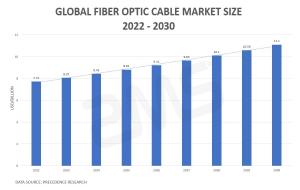With the development of communication technology, the demand for fiber optic cables continues to grow. This market is facing great opportunities and challenges.
LOS ANGELES, UNITED STATES, September 15, 2022 /EINPresswire.com/ — Fiber optic cable as a new generation of transmission medium has the advantages of large transmission capacity, low fading, long transmission distance, light weight, no electromagnetic interference, etc. At present, fiber optics is gradually becoming the main part of communication network.
The demand for fiber optic cables continues to grow with the development of communication technologies in various fields such as global Internet, 5G, IoT, and military.
Currently, the global fiber optic cable is in shortage. And the price of aerial fiber has increased by 70% from its historical low in March 2021, from USD 3.7 to USD 6.3 per kilometer. The global fiber optics market is expected to reach USD 11.18 billion by 2030, registering a CAGR of 9.3% during the forecast period.
Development of Optical Communication Technology
The future development of optical communication technology revolves closely around performance improvement and cost savings. One of the trends in fiber optic communication is the evolution of all optical network.
All optical network means that all the network transmission and switching processes are realized through fiber optic cables. Because it is not necessary to realize the electric-optical and optical-electric conversion in the middle of the communication lines, it can greatly improve the network speed. As the data shows, the bandwidth of copper access is only 512Kbps, but the bandwidth of all-optical network broadband can reach 50 to 100Mbps.
Another trend in fiber optic communications is the flattening of networks. The flattened transmission network will change from a tree-like architecture to a MESH architecture. This will not only reduce the number of devices and save hardware costs, but also reduce electricity expenses as well as manpower investment.
If the network needs to be more simplified, the support of advanced operations and maintenance (O&M) technology should be introduced. By introducing AI and big data technology, operators can achieve intelligent operation of the entire transmission network. When problems arise, AI can provide fast response and link scheduling to reduce the length of service interruptions.
Internet Development Drives Expanding Demand for Fiber Optic Cables
Internet services are further developed and people’s demand for high traffic and high-speed networks is growing. With the continuous construction of the IoT, cloud computing and mobile communication networks, etc., the fiber optic cable industry will witness broader development opportunities.
In the fixed broadband space, fiber optic Ethernet is currently available at standard speeds of 10Mbps, 100Mbps, and 1Gbps. The development of Ethernet technology has laid a strong foundation for the application of fiber optic cable in fixed broadband.
In the 5G space, according to the GSMA, operators worldwide will invest a total of $700 billion in 5G networks from 2021-2025. 1.8 billion 5G connections will be available by the end of 2025.
5G base stations will use UDN networking to achieve basic coverage. As 5G base stations use medium and high frequency resources, the coverage area of a single station will be smaller and the number of base stations will increase compared to 4G. The multiplication of the number of base stations will create a large demand for fiber optic lines for 5G bearer networks.
Submarine Fiber Optic Cable Contributes to Global Interconnection
Submarine fiber optic cables are the most important infrastructure in the digital age. And they occupy an important position in international communications. To date, a total of 1.2 million kilometers of submarine lines of fiber optics have been deployed worldwide.
Global integration and the booming digital economy have stimulated a rapid growth in international bandwidth demand. In addition to the traditional cable manufacturers and operators, in recent years, Microsoft, Google, Facebook and other Internet giants have also entered the submarine fiber optic cable market. This is mainly because the popularity of the Internet has given rise to the ever rapidly growing demand for huge amounts of data transmission.
The global submarine fiber optics market is expected to grow at a CAGR of 11.04% from 2021 to 2025, with an estimated size growth of over $3.8 billion during the period.
FTTx Development Goals Drive Fiber Optics Access
According to Bridge Market Research, the FTTx (fiber to the x) market will grow at a CAGR of 8.62% during the period 2022-2029. The market is likely to reach 1.34 billion by 2029.
North America is expected to dominate the FTTx market due to the growing demand for passive optical networks in the region. Asia Pacific will grow at the highest rate as governments are pushing for more investments in fiber optic broadband.
Fiber optic network construction in European countries is relatively weak. However, Germany Telecom announced that it will strive to achieve 10 million households with fiber optic in 2024. Spain launched the Digital Spain 2025 plan to promote the penetration of 100 Mbps broadband to 100%. The Italian government plans to spend 6.7 billion euros to expand its broadband network.
According to CRU forecasts, demand for fiber optic cable in emerging markets will grow at a CAGR of 5%-6% from 2022-2026. And FTTH penetration in Latin America, the Middle East and Africa is expected to reach 36% by 2026.
Challenges to Fiber Optic Cable Development
Price, lifetime, capacity and maintenance restrain the development of fiber optics industry. Although there is great potential for the development of overhead fiber optic cable, the fiber optics market is highly competitive. And the policy and technical aspects are facing uncertainties. There are still some risks in the development process.
At the same time, the service life of fiber optic cable products such as ADSS and OPGW is limited and maintenance is difficult. They are the inevitable pain points of industry development.
The serious overcapacity of optical rods leads to fierce price competition. While the price of upstream raw materials is rising, making fiber optics manufacturers once in a difficult situation.
The advance of fiber optic manufacturing technology, the research and development of new fiber optic products, and intelligent production can help solve the challenges facing the development of fiber optic cables to a certain extent.
ZMS Cable
ZMS Cable
+86 371 6782 9333
email us here
Visit us on social media:
Facebook
Twitter
LinkedIn
Other
![]()








































